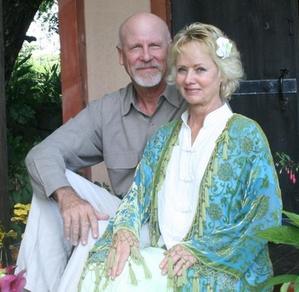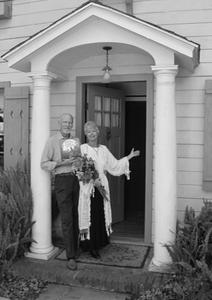
|
|
| photo: Craig Joujon-Roche | |
Audrey Wood and Don Wood, married couple and frequent collaborators, created the household and classroom classic The Napping House in 1984. The humorous cumulative text and detailed images have helped a generation of children feel successful as readers, many of them for the first time. After more than three decades, the Woods have returned to the cozy abode for a nighttime adventure, The Full Moon at the Napping House. In their first interview in 15 years, from their home in Hawaii, they discussed what prompted them to revisit Granny and her grandson in the Napping House.
Why did you decide to return to the Napping House after all this time?
Audrey Wood: It has been a process. The Napping House, when it was first published, had a low print run, and it just took off. Schools love to use it for patterning. It's a step-and-repeat story. They'd let kids--up to sixth grade even--read the book; they'd study it and they'd be inspired to create their own.
Over the years, we received stories children had written--their own versions about the Napping House. Reading the kids' stories, I'd get excited and think, I'll write another [one]. I would sit down, and go on an intense journey to try and find another Napping House. Nothing I came up with could match the original. I felt it stood on its own, and there was no reason to write another. I gave up, really.
What was the inspiration for the original Napping House?
AW: I wrote The Napping House when we lived in our house in Santa Barbara, when our son was three, and I'd put him down for a nap, and he was restless. Luckily my mother lived a few blocks away. I'd say, "Let's go to the napping house." We'd walk over there, and she had a big cozy bed, and a big cozy dog, and they'd be cozying up together reading a book. That's where the original idea came from.
Move forward in time, 20-some years, to our son moving to Hawaii and us falling in love with Hawaii. We moved here and we lived off the grid, right off the ocean, having an adventure in the middle of nowhere.
What happened while we were living in Hawaii is the moon and the stars. When you live where there's no light, they become your friends. We became very connected to the moon and very aware of it. Often during full moons I couldn't sleep; it was so bright outside. I'd take Neesha, our dog, for a walk. I discovered that I was not the only one who was really excited on a full moon night. We had two pet goats running around, chickens pecking and acting like it's daytime. We also had these wild geese, honking and flying around fussing at each other. I began to wonder, what would it be like if there were a full moon and everyone were restless. In the first book, everyone is sleepy and taking a nap. What if, like me, everyone in the napping house was being kept awake by the moon?
So for The Full Moon at the Napping House you had to come up with a creature that did for sleeping what the flea in Napping House does for waking.
AW: Yes. My challenge was that in the first book, it's daytime, and the characters stack up on each other and go to sleep, and then wake up. I needed a character that would do the opposite of that, that had the power to put all the characters to sleep--a night character, not a day character.
I went through so many animal books, animal kingdoms and queendoms and couldn't find a creature that would work. The words were coming, but I needed it to work as a whole. Lucky for me, I couldn't get to sleep again on a full moon night, and was just taking Neesha out when I heard this sound, and I knew immediately what it was, it was a cricket. I knew then and there that was my character.
When I was growing up as a child on a full moon night and couldn't get to sleep, my mother would say, just listen to the cricket chirping and make a wish on it, and it will come true. These two books came out of those two houses that Don and I have shared throughout our creative life.
Don, there's such a continuity in the art style between the two books. Has your process changed over these past three decades? Was it challenging to get back into that mindset?
DW: I started with oil and, in the tropics, the oils behave differently. They dry differently. I discovered open acrylics, which gave me the flexibility to blend on the page. I did change the media. That was very unusual to go back and to see this young Don Wood artist. He was pretty good. I'm 30 years on, I'm older, looser and more confident. I allowed the paint to do a little more of the work this time. It's inevitable that it's a slightly different book.
 |
|
|
Don and Audrey Wood in front of the original Napping House in Santa Barbara, Calif. |
|
Can you take us back to your first conception of the Napping House?
AW: I don't like systems. I've never taken a course in writing, but I've taught them. I read you're supposed to make files with story ideas, plot, characters. I felt so constrained that I created an Idea Box. Every morning when I wake up, I tell myself I want to be idea-hungry. The tiniest thing can lead to a story: my life experiences, something someone says, a doodle I'm doing on the phone. That's how Napping House started. I wrote a little note that said "Napping House" in my idea box. I also had a note about what a challenging thing it would be to write a story like "The House that Jack Built" and threw it in my idea box, along with sketches and articles, whatever interests me.
Certain times of the day, I'll want to write, and I take my Idea Box out and start going through these little notes. The synapses are firing, and it frees me up to use more of my imagination. I thought wow, the Napping House, they're in bed, with a dog--how about more animals, how about a cat? How about a mouse?
And did you have an image in mind of how they'd all wind up in the bed?
AW: Originally I wrote the story and it worked very well that all the characters are in the bed. They were in the bed together but not stacked on top of each other. Don puts on an editor hat for me, and I put on an art director had for him. He'll say, "I love this story, but for me as an artist, it would be more interesting to put them on top of each other." So back to the writing I go to see how I could incorporate that.
We love that readers see only the outside of the house and the well-kept grounds, and then Granny's bedroom. Did you consider including other rooms in the house?
AW: It's like writing a haiku. It has to be so succinct, so clipped, so multi-layered. If it had veered off into other rooms, it would have been a different story.
Full Moon took so many different approaches. I thought about using a girl instead of a boy. I had 15 different versions, and it took four or five months. Don says it was more like six months. Too scary for it not to be perfect--I have to be so absolutely sure. I might take six months to write something that seems very simple. He took a year and a quarter to illustrate The Full Moon at the Napping House.
DW: The nighttime setting was a challenge, and figuring it out was a bear. Audrey wrote a book called Moonflute, and I illustrated it. It took place outside. The Full Moon at the Napping House is set inside with no illumination; at the end of Full Moon the light is on and everything inside is cozy. I love when the light shines out and creates a rectangle on the lawn. We wanted to show more of the neighborhood; I put the camera back a bit.
Don, can you describe your process? Do you work from sketches first, before you apply acrylics? There's such a translucent quality to them, which works very well as moonlight scenes.
DW: I begin with sketches and make three or four dummies, to feel the turning of the pages. I then do final pencils, transferred onto the stretched stretcher with the canvas that I paint on. The open acrylics dry three times faster--it requires the meticulous blending of colors for Granny's blanket.
AW: We work together on the pagination and where the words are going to go, I make suggestions, and he does the same thing for me. I ask, "How can I make this more dynamic?"
DW: It's like having a really good art director living with you. I've had some great art directors, but none come close to Audrey. You sometimes are so close to a work that you can't see it.
AW: That's true in writing, too.

